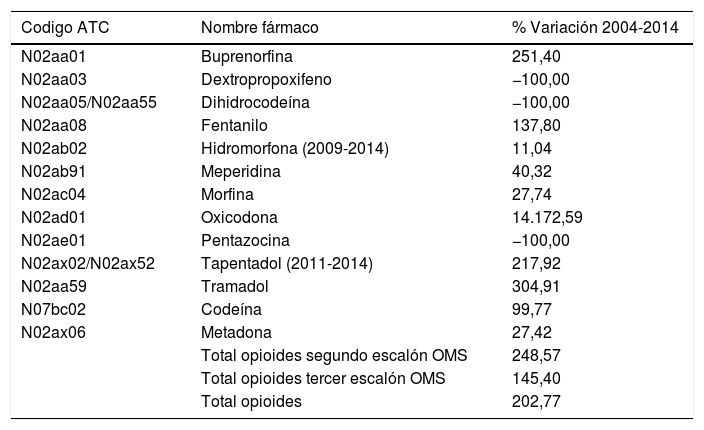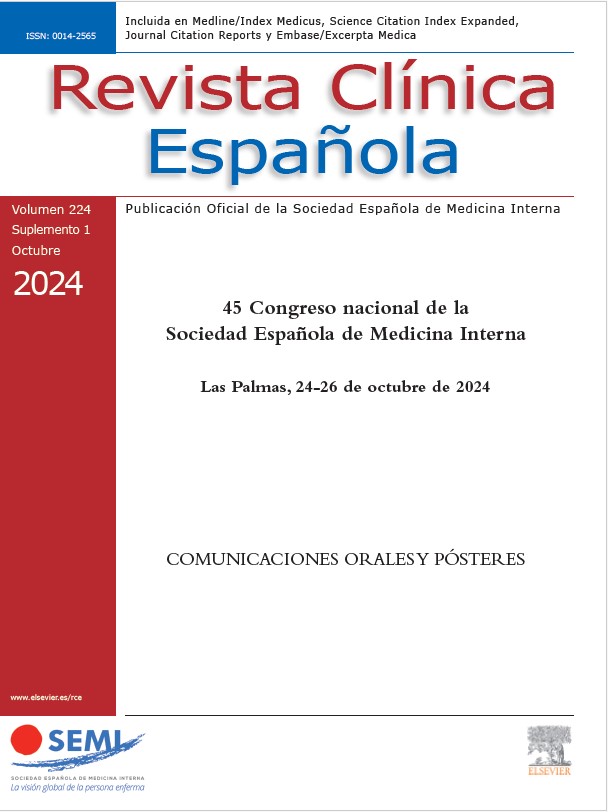El consumo de opioides es un indicador adecuado de cómo se trata el dolor. En España apenas existen estudios de la evolución del consumo y de su utilización pormenorizada en los distintos ámbitos.
Materiales y métodosEstudio analítico, observacional, retrospectivo de las prescripciones realizadas en la Comunidad de Madrid (CM) en toda la atención primaria (AP) y la atención especializada (AE) entre 2004 y 2014 y de tres grandes hospitales, para determinar la influencia de los distintos servicios en su prescripción.
ResultadosEl consumo de opioides en la CM entre 2004 y 2014 aumentó más de tres veces (DHD 2004: 2,67; 2014: 8,10). El tramadol fue el opioide globalmente más prescrito (DHD 2014: 4,12). Entre los de tercer escalón, el más utilizado fue el fentanilo (DHD 2014: 1,23). En AP los opioides más prescritos de tercer escalón fueron el fentanilo (DHD 2014: 0,92), seguido de la buprenorfina (DHD 2014: 0,31), la oxicodona (DHD 2014: 0,20) y el tapentadol (DHD 2014: 0,14). En AE los opioides más prescritos fueron el fentanilo (DHD 2014: 0,05), la oxicodona (DHD 2014: 0,03) y el tapentadol (DHD 2014: 0,02). En ambos casos la morfina representaba un porcentaje muy reducido (DHD 2014: AP 0,12 y AE 0,02). Por último, el opioide más utilizado en los hospitales fue la morfina (DHD 2014: 0,38), seguido del fentanilo (DHD 2014: 0,27) y la oxicodona (DHD 2014: 0,04). Los equipos de cuidados paliativos, tanto domiciliarios como hospitalarios, mostraron un consumo mayoritario de morfina (40-50% del total) y de metadona (35% del total).
ConclusionesEl consumo global de opioides en la CM se triplicó entre 2004 y 2014. El tramadol y el fentanilo fueron los más prescritos del segundo y tercer escalón analgésico, respectivamente. La morfina está teniendo un papel residual en la prescripción de opioides.
Opioid consumption is an appropriate indicator of pain treatment. In Spain, there are scarcely any studies on the evolution of the consumption of opioids and their detailed use in the various settings.
Material and methodsWe conducted an analytical, observational, retrospective study of prescriptions performed in the Community of Madrid in all primary care and specialized care centres and the three major hospitals between 2004 and 2014 to determine the influence of the various departments on the prescription of opioids.
ResultsOpioid consumption in Madrid between 2004 and 2014 increased more than 3-fold (2.67 vs. 8.10 defined daily doses/1000 inhabitants/day [DIDs] for 2004 and 2014, respectively).Tramadol was the most widely prescribed opioid (4.12 DIDs in 2014).Among the stepIII opioids, the most widely employed was fentanyl (1.23 DIDs in 2014). In primary care, the most prescribed stepIII opioids were fentanyl (0.92 DIDs in 2014), buprenorphine (0.31 DIDs in 2014), oxycodone (0.20 DIDs in 2014) and tapentadol (0.14 DIDs in 2014). In specialized care, the most prescribed opioids were fentanyl (0.05 DIDs in 2014), oxycodone (0.03 DIDs in 2014) and tapentadol (0.02 DIDs in 2014). In both cases, morphine represented a tiny percentage (0.12 primary care and 0.02 specialized care DIDs in 2014). Lastly, the most widely used opioid in the hospitals was morphine (0.38 DIDs in 2014), fentanyl (0.27 DIDs in 2014) and oxycodone (0.04 DIDs in 2014). For the palliative care teams (both home and hospital), the most consumed opioids were morphine (40-50% of the total) and methadone (35% of the total).
ConclusionsThe overall consumption of opioids in Madrid tripled between 2004 and 2014. Tramadol and fentanyl were the most prescribed of the stepII andIII analgesics, respectively. The role of morphine is diminishing in the prescription of opioids.
Artículo
Diríjase desde aquí a la web de la >>>FESEMI<<< e inicie sesión mediante el formulario que se encuentra en la barra superior, pulsando sobre el candado.

Una vez autentificado, en la misma web de FESEMI, en el menú superior, elija la opción deseada.

>>>FESEMI<<<












